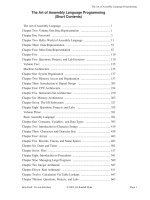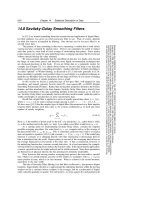Tài liệu Language Features of Java Generics pptx
Bạn đang xem bản rút gọn của tài liệu. Xem và tải ngay bản đầy đủ của tài liệu tại đây (36.88 KB, 5 trang )
Java Pro - Language Features of Java Generics />1/5 2004/5/20 上午 09:03
Print Article
Implementing Java Generics
Rough edges aside, see how the addition of Java
Generics adds substantial expressive power to the Java programming
language
by Klaus Kreft and Angelika Langer
Posted March 10, 2004
Editor's Note: This is the second of two installments presenting an overview of
Java Generics, a new language feature that will be supported in the upcoming
release of Java 2 Platform, Standard Edition 1.5. The first
installment—"Language Features of Java Generics
," Java Pro Online, March 3,
2004—discussed Java collections and generic treatment of types and classes.
This concluding installment will look at generic treatment of methods as well as
implementation and use of Java Generics.
T
ypes aren't the only components that can be parameterized. In addition to
generic classes and interfaces, we can define generic methods. Static and
nonstatic methods as well as constructors can be parameterized in pretty much
the same way as we described parameterizing types previously (see "
Language
Features of Java Generics," Java Pro Online, March 3, 2004). The syntax is a
little different, as you'll see. Everything said about type variables of parameterized
types applies to type variables of parameterized methods in the exact same way.
See
Listing 1
for an example of a parameterized static method: max().
Parameterized methods are invoked like regular nongeneric methods. The type
parameters are inferred from the invocation context. In our example, the compiler
would invoke max<Byte>() automatically. The type inference algorithm is
significantly more complex than this simple example suggests, and exhaustive
coverage of type inference is beyond the scope of this discussion.
For the sake of completeness let's touch briefly on wildcards. So far we have
been instantiating parameterized types using a concrete type that replaces the
type parameter in the instantiation. In addition, so-called wildcards can be used to
instantiate a parameterized type. A wildcard instantiation looks like this:
List<? extends Number> ref =
new LinkedList<Integer>();
In this statement List<? extends Number> is a wildcard instantiation, while
LinkedList<Integer> is a regular instantiation. There are three types of wildcards:
"? extends Type", "? super Type", and "?". Each wildcard denotes a family of
types. The "? extends Number" wildcard, for instance, is the family of subtypes of
type Number; "? super Integer" is the family of supertypes of type Integer; and "?"
is the set of all types. Correspondingly, the wildcard instantiation of a
parameterized type stands for a set of instantiations; for example, List<? extends
Number> refers to the set of instantiations of List for types that are subtypes of
Number.
Wildcard instantiations can be used for declaration of reference variables, but
they cannot be used for creation of objects. Reference variables of a wildcard
instantiation type can refer to an object of a compatible type, however.
Compatible in this sense are concrete instantiations from the family of
instantiations denoted by the wildcard instantiation. In a way, this is similar to
interfaces: we cannot create objects of an interface type, but a variable of an
interface type can refer to an object of a compatible type, and by "compatible" we
Java Pro - Language Features of Java Generics />2/5 2004/5/20 上午 09:03
mean a type that implements the interface.
Similarly, we cannot create objects of a wildcard instantiation type, but a variable
of the wildcard instantiation type can refer to an object of a compatible
type—"compatible" meaning a type from the corresponding family of
instantiations. Access to an object through a reference variable of a wildcard
instantiation type is restricted. Through a wildcard instantiation with "extends" we
must not invoke methods that take arguments of the type that the wildcard stands
for:
List list =
new LinkedList<Integer>();
list.add(new Integer(25));
// compile-time error
The add() method of type List takes an argument of the element type, which is the
type parameter of the parameterized List type. Through a wildcard instantiation
such as List<? extends Number> it is not permitted to invoke the add() method.
Similar restrictions apply to wildcards with "super"; methods where the return type
is the type that the wildcard stands for are prohibited. And both restrictions apply
for reference variables with a "?" wildcard.
This brief overview of wildcard instantiations is far from comprehensive;
exhaustive coverage of wildcards is beyond the scope of this discussion. In
practice, wildcard instantiations will show up most frequently as argument or
return types in method declarations, and only rarely in the declaration of
variables. The most useful wildcard is the "extends" wildcard. Examples for the
use of this wildcard can be found in the J2SE 1.5 platform libraries. One example
is the method Boolean addAll(Collection<? extends ElementType> c) of class
java.util.List. It allows the addition of elements to a List of element type
ElementType, where the elements are taken from a collection of elements that
are of a subtype of ElementType.
Now we have discussed all major language features related to Java generics:
parameterized types, parameterized methods, bounded type parameters, and
wildcard instantiations. Though there are many more details not covered here, we
want to forge ahead by exploring some of the underlying principles of JG, in
particular the translation of paramterized types and methods into Java byte code.
While this sounds pretty technical and mainly like a compiler builder's concern, an
understanding of these principles aids understanding of many of the less obvious
effects related to JG.
Under the Hood
How is JG implemented? What does the Java compiler do with our Java source
code that contains definitions and usages of parameterized types and methods?
Well, as usual, the Java compiler translates the Java source code into Java byte
code. Here we intend to take a look under the hood of the compilation process to
understand the effects and side effects of JG.
A compiler that must translate a parameterized type or method (in any language)
has in principle two choices:
Code specialization – The compiler generates a new representation for
every instantiation of a parameterized type or method. For instance, the
compiler would generate code for a list of integers and additional, different
code for a list of strings.
Code sharing – The compiler generates code for only one representation of
a parameterized type or method and maps all the concrete instantiations of
the generic type or method to the one unique representation, performing
type checks and type conversions where needed.
Code specialization is the approach that C++ takes for its templates. The C++
compiler generates executable code for every instantiation of a template. The
downside of code specialization of generic types is its potential for code bloat. A
list of integers and a list of strings would be represented in the executable code
as two implementations of two different types.
Java Pro - Language Features of Java Generics />3/5 2004/5/20 上午 09:03
This bloat is particularly wasteful in cases where the elements in a collection are
references (or pointers) because all references (or pointers) are of the same size
and internally have the same representation. There is no need for generation of
mostly identical code for a list of references to integers and a list of references to
strings. Both lists could be represented internally by a list of references to any
type of object. The compiler just has to add a couple of casts whenever these
references are passed in and out of the generic type or method. Since in Java
most types are reference types, it seems natural that Java chooses code sharing
as its technique for translation of generic types and methods. (C#, by the way,
uses both translation techniques for its generic types: code specialization for the
value types and code sharing for the reference types.)
One downside of code sharing is that it creates problems when primitive types
are used as parameters of generic types or methods. Values of primitive type are
of different size and require that different code is generated for a list of int and a
list of double, for instance. It's not feasible to map both lists onto a single list
implementation. There are two solutions to this problem:
No primitive types – Primitive types are prohibited as type arguments of
parameterized types or methods, that is, the compiler rejects instantiations
such as a List.
Boxing – Primitive type values are boxed automatically so that, internally,
references to the boxed primitive value were used. (Boxing is the process of
wrapping a primitive value into its corresponding reference type, and
unboxing is the reverse [see
Resources
].) Naturally, boxing has a negative
effect on performance because of the extra box and unbox operations.
Java Generics uses the first approach and restricts instantiation of generics to
reference types, hence, a LinkedList<int> is illegal in Java. (In C++ and C#
primitive types are allowed as type arguments because these languages use
code specialization: in C++ for all instantiations and in C# at least for
instantiations on primitive types).
Type Erasure
Let's turn to the details of the code sharing implementation of JG. The key
question is: how exactly does the Java compiler map different instantiations of a
parameterized type or method onto a single representation of the type or
method?
The translation technique used by the Java compiler can be imagined as a
translation from generic Java source code back into regular Java code. The
translation technique is called type erasure; the compiler removes all occurrences
of the type variables and replaces them by their leftmost bound or type Object, if
no bound had been specified. For instance, the instantiations LinkedList<Integer>
and a LinkedList<String> in a previous example (see
Listing 2
) would be
translated into a LinkedList<Object>, or LinkedList for short, and the methods
max<Integer>() and max<String>() (see Listing 1
) would be translated to
max<Comparable>(). In addition to removal of all type variables and replacing
them by their leftmost bound, the compiler inserts a couple of casts in certain
places and adds so-called bridge methods where needed.
Java designers deliberately chose the translation from generic Java code into
regular Java code. One key requirement to all new language features in Java 1.5
is their compatibility with previous versions of Java. In particular, it is required that
a pre-1.5 Java Virtual Machine must be capable of executing 1.5 Java code,
which is achievable only if the bytecode resulting from a 1.5 Java source looks
like regular byte code resulting from pre-1.5 Java code. Type erasure meets this
requirement: after type erasure there is no difference anymore between a
parameterized and a regular type or method.
For explanatory reasons we described the type erasure as a translation not from
generic Java code into regular nongeneric Java code. However, this is not exactly
true; the translation is from generic Java code directly to Java byte code.
Nevertheless, we will subsequently refer to the type erasure process as a
translation from generic Java to nongeneric Java.
Java Pro - Language Features of Java Generics />4/5 2004/5/20 上午 09:03
Listing 3
illustrates the translation by type erasure and shows the type erasure of
our previous example of generic types (see
Listing 2
). As you can see, all
occurrences of the type variable A are replaced by type Object. The
implementation of our generic collection is now exactly like an implementation
that uses the traditional Java technique for genericity—namely, implementation in
terms of Object references.
The sample code also gives you an example of an automatically inserted cast. In
the main() method, where a linked list of strings is used, the compiler added a
cast from Object to String. See
Listing 4
for a type erasure of our parameterized
max() method from Listing 1
.
Again, all occurrences of type variables are replaced by either type Object (in the
Comparable interface) or the leftmost bound (type Comparable in the max()
method). We see the inserted cast from Object to Byte in the main() method,
where the generic method is invoked for a collection of Bytes, and we see an
example of a bridge method in class Byte.
The compiler inserts bridge methods in subclasses to ensure overriding works
correctly. In the example, class Byte implements interface Comparable<Byte>
and must therefore override the superinterface's compareTo() method. The
compiler translates the compareTo() method of the generic interface
Comparable<A> to a method that takes an Object, and translates the
compareTo() method in class Byte to a method that takes a Byte. After this
translation, method Byte.compareTo(Byte) is no overriding version of method
Comparable<Byte>.compareTo(Object) any longer because the two methods
have different signatures as a side effect of translation by erasure. To enable
overriding, the compiler adds a bridge method to the subclass. The bridge
method has the same signature as the superclass's method that must be
overridden and delegates to the other methods in the derived class that was the
result of translation by erasure.
Exploration
We've provided an overview of all major language features related to
parameterized types and methods. Naturally, coverage of a fairly complex
language feature such as JG could be given far more space. There are many
more details to be explored and understood before JG can be used reliably and
effectively. The greatest difficulties in using and understanding JG stem perhaps
from the type erasure translation process by which the compiler elides all
occurrences of the type parameters, which leads to quite a number of surprising
effects. For example, arrays of parameterized types are prohibited in Java, that is,
Comparable<String>[] is an illegal type, while Comparable[] is permitted.
This characteristic is surprising at best and turns out to be quite a nuisance in
practice. It boils down to the fact that arrays are best avoided and replaced by
collections as soon as the element type is a parameterized type. This realization
and many other tips and techniques demand thorough exploration before the new
language feature can be exploited to its capacity. Despite the rough edges here
and there, the addition of JG adds substantial expressive power to the Java
programming language. Our own experience is that once you've been using
generics for a while, you'll miss them badly if you have to return to nongeneric
Java with its unspecific types and countless casts and runtime checks.
About the Authors
Klaus Kreft is a senior consultant and software architect for Siemens Business
Services. He has delivered consultancy services to large-scale industry projects
for almost 20 years and used Java since 1995. Angelika Langer is a freelance
trainer/consultant. She was involved in compiler construction in the '90s and has
been watching closely the development of C++, Java, and C#. Her teaching is
backed by over 12 years of work as a developer in the software industry and over
8 years of training and consulting. Angelika is also author of an independent
curriculum of introductory and advanced C++ and Java courses. The authors are
speakers at international conferences, they authored Standard C++ IOStreams
and Locales, and they wrote numerous articles about C++ and Java, including
columns for C++ Report and JavaSpektrum. Visit www.langer.camelot.de
for
further information. Contact Klaus at
, and contact
Java Pro - Language Features of Java Generics />5/5 2004/5/20 上午 09:03
Angelika at
© Copyright 2001-2004 Fawcette Technical Publications | Privacy Policy | Contact Us









